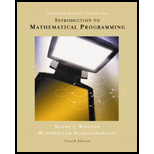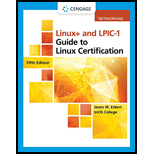
Introduction to mathematical programming
4th Edition
ISBN: 9780534359645
Author: Jeffrey B. Goldberg
Publisher: Cengage Learning
expand_more
expand_more
format_list_bulleted
Concept explainers
Expert Solution & Answer
Chapter 4.10, Problem 3P
Explanation of Solution
LINGO output
- LINGO is an optimization modelling language that enables user to create many constraints or objective function terms by typing one line.
- LINGO is used to solve both linear and nonlinear problems.
- It is a software tool which is designed efficiently for building and solving linear, nonlinear and integer optimization.
- The LINGO model consists of three parts which are objective function, variables and constraints.
- The objective function is a formula that describes what the model optimizes exactly.
- Variables are the quantities that can be changed for producing the optimal value of the objective function.
- The constraint is the formula that defines the limits on the values of the variables...
Expert Solution & Answer
Trending nowThis is a popular solution!

Students have asked these similar questions
Specifications: Part-1Part-1: DescriptionIn this part of the lab you will build a single operation ALU. This ALU will implement a bitwise left rotation. Forthis lab assignment you are not allowed to use Digital's Arithmetic components.IF YOU ARE FOUND USING THEM, YOU WILL RECEIVE A ZERO FOR LAB2!The ALU you will be implementing consists of two 4-bit inputs (named inA and inB) and one 4-bit output (named
out). Your ALU must rotate the bits in inA by the amount given by inB (i.e. 0-15).Part-1: User InterfaceYou are provided an interface file lab2_part1.dig; start Part-1 from this file.NOTE: You are not permitted to edit the content inside the dotted lines rectangle.Part-1: ExampleIn the figure above, the input values that we have selected to test are inA = {inA_3, inA_2, inA_1, inA_0} = {0, 1, 0,0} and inB = {inB_3, inB_2, inB_1, inB_0} = {0, 0, 1, 0}. Therefore, we must rotate the bus 0100 bitwise left by00102, or 2 in base 10, to get {0, 0, 0, 1}. Please note that a rotation left is…
How can I perform Laplace Transformation when using integration based on this? Where we convert time-based domain to frequency domain
what would be the best way I can explain the bevhoirs of Laplace and Inverse Transofrmation In MATLAB.
Chapter 4 Solutions
Introduction to mathematical programming
Ch. 4.1 - Prob. 1PCh. 4.1 - Prob. 2PCh. 4.1 - Prob. 3PCh. 4.4 - Prob. 1PCh. 4.4 - Prob. 2PCh. 4.4 - Prob. 3PCh. 4.4 - Prob. 4PCh. 4.4 - Prob. 5PCh. 4.4 - Prob. 6PCh. 4.4 - Prob. 7P
Ch. 4.5 - Prob. 1PCh. 4.5 - Prob. 2PCh. 4.5 - Prob. 3PCh. 4.5 - Prob. 4PCh. 4.5 - Prob. 5PCh. 4.5 - Prob. 6PCh. 4.5 - Prob. 7PCh. 4.6 - Prob. 1PCh. 4.6 - Prob. 2PCh. 4.6 - Prob. 3PCh. 4.6 - Prob. 4PCh. 4.7 - Prob. 1PCh. 4.7 - Prob. 2PCh. 4.7 - Prob. 3PCh. 4.7 - Prob. 4PCh. 4.7 - Prob. 5PCh. 4.7 - Prob. 6PCh. 4.7 - Prob. 7PCh. 4.7 - Prob. 8PCh. 4.7 - Prob. 9PCh. 4.8 - Prob. 1PCh. 4.8 - Prob. 2PCh. 4.8 - Prob. 3PCh. 4.8 - Prob. 4PCh. 4.8 - Prob. 5PCh. 4.8 - Prob. 6PCh. 4.10 - Prob. 1PCh. 4.10 - Prob. 2PCh. 4.10 - Prob. 3PCh. 4.10 - Prob. 4PCh. 4.10 - Prob. 5PCh. 4.11 - Prob. 1PCh. 4.11 - Prob. 2PCh. 4.11 - Prob. 3PCh. 4.11 - Prob. 4PCh. 4.11 - Prob. 5PCh. 4.11 - Prob. 6PCh. 4.12 - Prob. 1PCh. 4.12 - Prob. 2PCh. 4.12 - Prob. 3PCh. 4.12 - Prob. 4PCh. 4.12 - Prob. 5PCh. 4.12 - Prob. 6PCh. 4.13 - Prob. 2PCh. 4.14 - Prob. 1PCh. 4.14 - Prob. 2PCh. 4.14 - Prob. 3PCh. 4.14 - Prob. 4PCh. 4.14 - Prob. 5PCh. 4.14 - Prob. 6PCh. 4.14 - Prob. 7PCh. 4.16 - Prob. 1PCh. 4.16 - Prob. 2PCh. 4.16 - Prob. 3PCh. 4.16 - Prob. 5PCh. 4.16 - Prob. 7PCh. 4.16 - Prob. 8PCh. 4.16 - Prob. 9PCh. 4.16 - Prob. 10PCh. 4.16 - Prob. 11PCh. 4.16 - Prob. 12PCh. 4.16 - Prob. 13PCh. 4.16 - Prob. 14PCh. 4.17 - Prob. 1PCh. 4.17 - Prob. 2PCh. 4.17 - Prob. 3PCh. 4.17 - Prob. 4PCh. 4.17 - Prob. 5PCh. 4.17 - Prob. 7PCh. 4.17 - Prob. 8PCh. 4 - Prob. 1RPCh. 4 - Prob. 2RPCh. 4 - Prob. 3RPCh. 4 - Prob. 4RPCh. 4 - Prob. 5RPCh. 4 - Prob. 6RPCh. 4 - Prob. 7RPCh. 4 - Prob. 8RPCh. 4 - Prob. 9RPCh. 4 - Prob. 10RPCh. 4 - Prob. 12RPCh. 4 - Prob. 13RPCh. 4 - Prob. 14RPCh. 4 - Prob. 16RPCh. 4 - Prob. 17RPCh. 4 - Prob. 18RPCh. 4 - Prob. 19RPCh. 4 - Prob. 20RPCh. 4 - Prob. 21RPCh. 4 - Prob. 22RPCh. 4 - Prob. 23RPCh. 4 - Prob. 24RPCh. 4 - Prob. 26RPCh. 4 - Prob. 27RPCh. 4 - Prob. 28RP
Knowledge Booster
Learn more about
Need a deep-dive on the concept behind this application? Look no further. Learn more about this topic, computer-science and related others by exploring similar questions and additional content below.Similar questions
- What IETF protocol is NetFlow associated with? Group of answer choices IPX/SPX IPIX HTTPS SSHarrow_forwardHow can I perform Laplace Transformation when using integration based on this?arrow_forwardWrite an example of a personal reflection of your course. - What you liked about the course. - What you didn’t like about the course. - Suggestions for improvement. Course: Information and Decision Sciences (IDS) The Reflection Paper should be 1 or 2 pages in length.arrow_forward
- using r languagearrow_forwardI need help in explaining how I can demonstrate how the Laplace & Inverse transformations behaves in MATLAB transformation (ex: LIke in graph or something else)arrow_forwardYou have made the Web solution with Node.js. please let me know what problems and benefits I would experience while making the Web solution here, as compared to any other Web solution you have developed in the past. what problems and benefits/things to keep in mind as someone just learningarrow_forward
- PHP is the server-side scripting language. MySQL is used with PHP to store all the data. EXPLAIN in details how to install and run the PHP/MySQL on your computer. List the issues and challenges I may encounter while making this set-up? why I asked: I currently have issues logging into http://localhost/phpmyadmin/ and I tried using the command prompt in administrator to reset the password but I got the error LOCALHOST PORT not found.arrow_forwardHTML defines content, CSS defines layout, and JavaScript adds logic to the website on the client side. EXPLAIN IN DETAIL USING an example.arrow_forwardusing r languangearrow_forward
arrow_back_ios
SEE MORE QUESTIONS
arrow_forward_ios
Recommended textbooks for you
 C++ Programming: From Problem Analysis to Program...Computer ScienceISBN:9781337102087Author:D. S. MalikPublisher:Cengage Learning
C++ Programming: From Problem Analysis to Program...Computer ScienceISBN:9781337102087Author:D. S. MalikPublisher:Cengage Learning Operations Research : Applications and AlgorithmsComputer ScienceISBN:9780534380588Author:Wayne L. WinstonPublisher:Brooks Cole
Operations Research : Applications and AlgorithmsComputer ScienceISBN:9780534380588Author:Wayne L. WinstonPublisher:Brooks Cole LINUX+ AND LPIC-1 GDE.TO LINUX CERTIF.Computer ScienceISBN:9781337569798Author:ECKERTPublisher:CENGAGE L
LINUX+ AND LPIC-1 GDE.TO LINUX CERTIF.Computer ScienceISBN:9781337569798Author:ECKERTPublisher:CENGAGE L C++ for Engineers and ScientistsComputer ScienceISBN:9781133187844Author:Bronson, Gary J.Publisher:Course Technology PtrProgramming Logic & Design ComprehensiveComputer ScienceISBN:9781337669405Author:FARRELLPublisher:Cengage
C++ for Engineers and ScientistsComputer ScienceISBN:9781133187844Author:Bronson, Gary J.Publisher:Course Technology PtrProgramming Logic & Design ComprehensiveComputer ScienceISBN:9781337669405Author:FARRELLPublisher:Cengage

C++ Programming: From Problem Analysis to Program...
Computer Science
ISBN:9781337102087
Author:D. S. Malik
Publisher:Cengage Learning

Operations Research : Applications and Algorithms
Computer Science
ISBN:9780534380588
Author:Wayne L. Winston
Publisher:Brooks Cole

LINUX+ AND LPIC-1 GDE.TO LINUX CERTIF.
Computer Science
ISBN:9781337569798
Author:ECKERT
Publisher:CENGAGE L

C++ for Engineers and Scientists
Computer Science
ISBN:9781133187844
Author:Bronson, Gary J.
Publisher:Course Technology Ptr


Programming Logic & Design Comprehensive
Computer Science
ISBN:9781337669405
Author:FARRELL
Publisher:Cengage